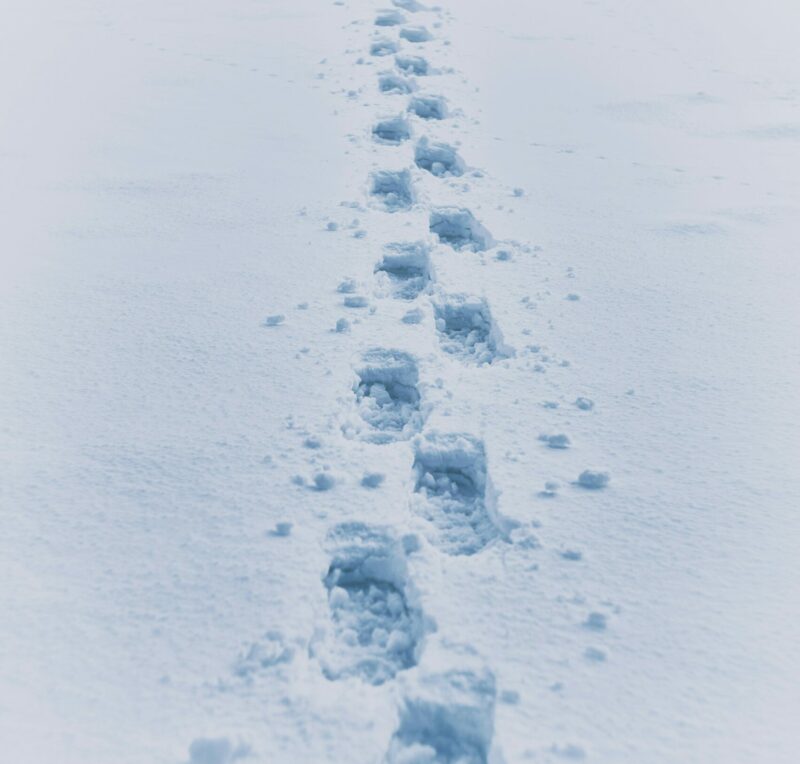
Minnesota’s winter landscapes are nothing short of magical, with serene snowy forests, sparkling frozen lakes, and breathtaking views that attract outdoor enthusiasts every year. Whether you’re winter hiking through dense woods or exploring the tranquil shores of frozen lakes, it’s essential to follow care for place practices to help steward Minnesota’s natural beauty. Adopting the principles of Leave No Trace (LNT) during your winter travels is a key part of this effort, ensuring that future generations can experience the same pristine wilderness we enjoy today. Here’s a guide on how to travel lightly and responsibly this winter while leaving only footprints behind.
What Does “Leave No Trace” Mean?
Leave No Trace refers to a set of principles designed to minimize human impact on our shared natural places. The concept encourages visitors to respect the land, avoid leaving waste behind, and take steps to care for natural areas. In winter, this philosophy is especially important as fragile ecosystems can be easily disrupted by foot traffic, litter, and improper behavior. Whether you’re heading out for a day of winter hiking or enjoying other outdoor activities, following the Leave No Trace guidelines ensures that you are preserving Minnesota’s natural spaces for future adventurers.
How to Practice Leave No Trace in Winter
Winter activities, such as hiking, snowshoeing, and skiing, require special attention to ensure we are minimizing our impact on our natural places. Here are several ways to practice Leave No Trace while enjoying the winter wonderland of Minnesota.
1. Stick to Designated Trails
One of the most effective ways to be a godo steward of Minnesota’s delicate winter ecosystems is to stick to designated trails and paths when winter hiking or snowshoeing. By following existing routes, you help prevent soil erosion, damage to plant life, and the trampling of habitats. Many state parks, wildlife areas, and nature reserves in Minnesota offer well-maintained trails that can be enjoyed even in winter. Before you go, check trail conditions online to ensure that the path is open and suitable for winter activities.
2. Be Mindful of Wildlife
Winter is a tough time for many of Minnesota’s animals. When hiking or exploring nature, be mindful of wildlife and avoid disturbing animals, especially in colder months when food can be scarce. Keep a safe distance from animals, and never feed them. Winter hikers should be particularly cautious of animals who are more vulnerable during this season, including deer, elk, and certain bird species. If you come across animal tracks, enjoy them from a distance and avoid stepping off the trail into sensitive areas.
3. Pack Out Everything You Bring In
In winter, it’s easy to overlook the importance of packing out your waste, but it’s just as important during the colder months as it is in warmer weather. Snow can quickly hide litter, but it doesn’t make the trash disappear. Always carry a small bag to collect trash, wrappers, food scraps, and even biodegradable waste like apple cores. If you’re enjoying a warm beverage or snack during your winter hike, remember to pack out all your wrappers and containers. You can leave the natural world pristine while still enjoying your outdoor activities.
4. Keep Noise to a Minimum
Winter activities often take place in quiet, peaceful environments, and excessive noise can disrupt both the natural setting and wildlife. Keep your voice down while on trails, especially if you’re in a designated wilderness area or wildlife refuge. The stillness of winter allows us to fully appreciate the sounds of nature, from the crunch of snow beneath your boots to the chirping of winter birds.
5. Be Cautious of Ice and Snow
When engaging in winter activities like ice fishing, skiing, or snowshoeing, make sure to follow safe practices. For instance, avoid disturbing the snow and ice around lakes when snowshoeing or skiing, as this can disrupt the natural spaces. Stick to marked paths on frozen lakes to avoid damaging delicate ecosystems beneath the ice.
6. Respect Winter Camping Guidelines
If you’re winter camping in Minnesota, follow specific Leave No Trace practices to minimize your impact on the landscape. Choose established campsites or areas that are already disturbed to set up camp. When building a fire, use established fire rings or portable stoves to prevent damaging the area. Never cut down live trees or branches for firewood. Pack out all trash and leftover food, and leave the campsite looking as if you were never there.
Travel Tips for Winter Adventures
In addition to following Leave No Trace principles, here are a few more ways to make your winter travel in Minnesota more sustainable:
- Carpool or Use Public Transportation: If you’re visiting popular winter destinations, consider carpooling with friends or using public transportation.
- Use Eco-Friendly Gear: Choose winter gear made from sustainable materials. Opt for reusable water bottles, eco-friendly clothing, and biodegradable soaps.
- Choose Eco-Friendly Accommodations: Many lodges, cabins, and hotels in Minnesota now emphasize energy-efficient practices and environmental stewardship. Look for accommodations that prioritize sustainability.
Why It Matters for Minnesota
Minnesota’s vast wilderness areas, including the Boundary Waters Canoe Area Wilderness (BWCA), Itasca State Park, and the North Shore, are some of the most cherished landscapes in the state. These spaces offer unparalleled opportunities for winter hiking, skiing, and exploring, but they also face pressures from overuse and human impact. By practicing Leave No Trace principles, we can ensure that these areas remain pristine for future generations of Minnesotans to enjoy.
This winter, as you head out to explore the snowy beauty of Minnesota, remember to travel responsibly and Leave Only Footprints. By following Leave No Trace practices, sticking to designated trails, respecting wildlife, and minimizing your footprint, you’ll help preserve Minnesota’s winter wonderland for years to come.
Find Your Next
We invite you to share the ways you care for Minnesota’s natural place to inspire others to go Upstream.